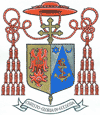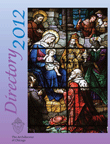
The Cardinal's Column
Francis Cardinal George, O.M.I.
‘Behold, I make all things new …’
Cardinal's Appointments
December 20, 2006
His Eminence, Francis Cardinal George announces the following appointments:
Retired
Rev. Francis Cimarrusti, from counselor at Holbrook Counseling, to retire after forty-three years of service to parishes and Catholic Charities of the Archdiocese of Chicago, and be pastor emeritus of Our Lady of the Angels Parish, effective Jan. 1, 2007.
Rev. John Rudnik, from Parochial Vicar of Transfiguration Parish, West Carmen, to retire after forty-five years of service, and be Parochial Vicar Emeritus of the same, effective Dec.

Cardinal George's Schedule
- January 7: 10 a.m., Commencement Liturgy, St. Xavier University
- January 8: 10 a.m., Episcopal Council Meeting, Residence
- January 9: 9:30 a.m., Presbyteral Council Meeting, De Paul O’Hare Campus
- January 11: 7 p.m., Diaconate Candidates Meeting, Holy Name Cathedral
- January 12: 2 p.m., Board of Advisors Meeting, University of St. Mary of the Lake
- January 13: 9 a.m., Archdiocesan Women’s Committee Meeting, Pastoral Center; 5:30 p.m., Mass, St. Gerard Majella, Markham
Hanging on a wall in my sitting room is a contemporary icon of the Blessed Virgin Mary, "written" by a monk of Mt. Angel Abbey in Oregon ten years ago. It was a gift to me from the monks to welcome me as Archbishop of Portland, and it combines in one image two titles of Mary: Our Lady of Guadalupe and Our Lady of the Snows.
Pictured in the icon, Mary is clothed as she is seen on the cloak or tilma in Mexico City, wearing a blue mantle with stars of gold. But she has already given birth to Jesus, who is pictured wrapped in swaddling clothes. In the usual pictures of Our Lady of Guadalupe, Mary is wearing a black sash around her waist, a sign she is pregnant. In the icon in my room, it is the newly born Jesus who wears the black sash, because he is pregnant with a new world.
What kind of world does Jesus bring forth? It is not just a better world but a different world, a new world. In the story of the apparition to St. Juan Diego (A.D. 1531), Our Lady of Guadalupe tells him to gather roses from the hillside into his cloak and bring them to the Bishop of Mexico. When Juan Diego does so and opens his cloak, the roses spill out and the bishop sees the image we still venerate. It was December.
In my icon, the figures of Jesus and Mary are framed by stylized clouds of snow and ice. In the story of Our Lady of the Snows, a dream comes to the Pope in Rome after the Ecumenical Council of Ephesus (A.D. 431), which was called to respond to several heresies about Jesus, some making him less than human and others making him less than divine. The Council, to make clear what the apostolic faith holds and has always held about Jesus, recognized his human mother as the God-bearer, the Mother of God. Wanting to build a church in honor of the Mother of God, the Pope dreamt that God would have it built on the Esquiline hill in Rome. The outlines of the church’s walls were clear the next morning in a snowfall on the hill. It was August.
The world that Jesus brings forth is a world where roses bloom in December in Mexico and snow falls in August in Rome. It is a world made new, even though it might usually look the same as always. It is a world where God’s love is now made flesh and, in the same human flesh, we are made new in that divine love. No longer condemned to the endless cycle of its own sinfulness, the human race is open to salvation, radical newness, in and through Christ.
This week we enter a new year in the history of the human race, and we wish each other the happiness that lies in hope. Personally, I hope that 2007 will be a better year for me and for the Archdiocese than was 2006. That hope is not just whistling in the dark and that happiness is not to be found in escapist diversions, because our faith keeps us in touch with the world redeemed by Christ and shaped, even when we don’t understand how, by God’s loving providence.
How might we designate this new year in the Archdiocese? Almost three years ago, we celebrated with the Universal Church the Year of the Eucharist. The Eucharist is the great gift of the risen Christ’s real presence to his people in the Blessed Sacrament. Along with the long-standing attention to good Eucharistic liturgy in our churches, many parishes have also begun periods of Eucharistic adoration. These hours spent with the Lord in silent prayer transform hearts and minds and make us better agents of the new world brought forth by Christ. In the summer of the Year of the Eucharist, there was a procession and adoration of the Blessed Sacrament in Grant Park, made possible by the Knights of Columbus at the end of their national convention here. Catechesis on the gift of the Eucharist also marked the Archdiocese’s participation in the Year of the Eucharist.
At the end of that year, the Archdiocese began a Year of Evangelization. Like the Eucharist, evangelization is always with us, since it is a word that expresses the permanent mission of the Church. Still, it made sense to turn to evangelizing with renewed effort last year, because renewed appreciation of the Eucharist the year before should have stirred up a desire on our part to share this and other gifts of Christ more widely. More explicit attention to reaching out to others with the gifts of Christ gave birth to Mission Chicago and other events around the Archdiocese in our three major languages. I’m especially grateful to Fr. Bob Barron, of the Mundelein Seminary faculty, for the conferences he gave on bringing the faith into every area of human endeavor. Just as Eucharistic celebration and devotion continue after the Year of the Eucharist, so reaching out to share the faith continues after the Year of Evangelization.
What about the new year? What I hear from the Archdiocesan Pastoral Council and some others is that a deeper understanding of the faith is needed if we are to become an evangelizing Church, and a deeper appreciation of how Christ makes all things new, how he calls us to conversion, is necessary to live the Catholic faith authentically today. The Presbyteral Council has begun discussing how priests might respond to this request from the laity. Perhaps we can continue these conversations by framing them in a Year of Spirituality.
Spirituality is a fashionable word these days because it recognizes a dimension of human experience that transcends the habits and lassitude of daily life. Spirituality is a word that reminds us that the world can be made new. Sometimes, however, it is used in contrast to faith or religion. A spirituality can be fashioned by an individual according to his or her own instincts or experience; a faith or a religion is a collective reality not open to individual manipulation. A spirituality can be just a work of personal imagination; faith is a response to what God has revealed and done for our salvation. Since we are formed in a culture that favors individualism, subjective spirituality can seem more attractive than a historical faith that seems to confine rather than set free. The difficulty, of course, is that spirituality divorced from faith is always delusional. It leaves each of us stuck in the worst of all possible worlds, a world of one.
In the context of the recent Year of the Eucharist and the Year of Evangelization, a Year of Spirituality might help us deepen our relationship to Christ and one another in the context of the faith that comes to us from the Apostles. At least, that’s one hope I have as I begin to discuss with priests and others what a Year of Spirituality in the Archdiocese might become. In the meantime, may the Lord who has come to "make all things new" (Revelation 21: 5) bless all of us with a New Year filled with his grace.
Sincerely yours in Christ,
Francis Cardinal George, OMI
Archbishop of Chicago



